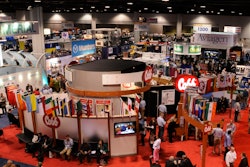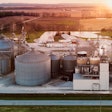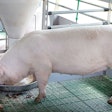从i - 80高速公路向南驱车向Fairm 81ont, NE, you’ll see plenty of elevators and grain legs jaggedly brushing the skyline. Nearing Fairmont, you quickly spot a new elevator, about a mile west of the Highway 6 and 81 intersection. You have to wonder, why here in the midst of so many other grain operations, with an ethanol plant a few miles south, did someone sprout a 2.1 million bushel facility?
You’ll get an answer rather quickly. It’s there because “everything fell into place,” assures Bob Fifield, CEO of Cooperative Producers Inc (CPI), based in Hasting, NE. The elevator is a joint venture of CPI and Lansing Trading Company. Talking with Fifield, along with Dan Olson, CPI’s COO, and Calvin Diehl, facility manager, and getting a tour of the facility, it’s hard to disagree.
The “everything” Fifield refers to includes location, market research, need and opportunity, design, permitting, construction and the final outcome — a safe, efficient facility completed ontime and on budget. Perhaps most interesting, the elevator was little more than an idea in mid-2011. In fact, they first met with railroad representatives on a potential site in August 2011, Olson pointed out.
That meeting was key. CPI/Lansing has a joint venture shuttle-loading facility in Red Cloud, NE, and saw the need to grow with a second shuttle-loader facility. With a BNSF rail running parallel to east/west Highway 6, and near the 4-lane, north-south Highway 81, Fairmont was a viable option. Research showed “there was about a 35-mile void, north and south,” for storage, Olson states. Lansing’s research on production and freight spreads and CPI’s research of the competitive landscape and logistics zeroed in on the location, and the railroad folks agreed. From fall of 2011 they went into design/build mode, began construction in January/February of 2012, and brought the new facility online in March of this year.
The design process was smooth, the CPI staff says, because so many of the design concepts were thought-through ahead of time. Many of the ideas came from Fifield, who worked several years for ADM, including involvement with facility construction.
Built for Speed, Expansion
Traffic flow was a key factor in designing for fast receiving and load-out while leaving room for expansion. To understand the flow, picture two traffic loops sitting next to each other — one on the west for rail, one on the east for trucks.
Whether east- or west-bound on the main line, trains switch onto the CPI/Lansing loop at the southwest corner of the site. They then head east on the loop, entering load-out from the north or south, depending on their original direction.
Trucks enter from the southeast corner of the site, head west, then follow a loop north around the office, and south across the scale. The relatively long access road will prevent crowding and allow for a steady traffic flow during harvest.
At their closest point, the two loops are separated by a two-story control center. An operator on the ground floor monitors receiving; an operator on the second floor can see the tracks, monitor the rail cars and load-out, and easily cross the room to see what’s going on in receiving. Each of the two rooms has a touch-screen control panel so operators can track grain movement and conditions throughout the facility.
On both sides of the control center, capacity equals efficiency. The railroad has agreed to continue powering the cars and CPI/Lansing will have three people trained to handle the engine. So, fed by a 60,000-bushel/hour load-out leg with bulkweigher, and with no need to unhook and change power, cars are loaded quickly (3 to 3.5 minutes) and keep moving to get back on the main rail line.
On the receiving side, drivers swipe an RFID card, roll onto the Fairbanks scale, and the load is probed and weighed. They’re then directed to one of two side-by-side pits. Two hoppers can be unloaded at the same time and, with each 1,200-bushel pit feeding a 30,000-bushels/hour leg, grain moves fast. “We had to let some of the drivers know it was okay to crank their gates all the way open,” Diehl notes.
Emptied, trucks continue south, cross the outbound scale, are weighed, ticketed, and head to the highway. By design, then proven with the 300,000-plus bushels moved so far, a truck can go from initial card swipe to rolling off the outbound scale in four minutes. “We did get one through in 3 minutes and 20 seconds,” Diehl adds, smiling.
Not that anyone is counting.
Inside the rail loop, stretching west from the control rooms, sit the Zimmerman 7,500-bushel/hour dryer, the 1.25 million bushel 8-pack slipform concrete elevators and a GSI 750-bushel steel storage structure. Though snug against the rail on the east, there’s a long stretch to the west for expansion. While the space is there, their goal now is to hit their business-plan objective of moving 15 to 20 million bushels annually. Their target is to have throughput of about 12-times capacity — 25 million bushels/year.
“We have speed and space,” is how Olson puts it. Fifield provides a different analogy. “Churches are built for Easter Sunday [crowds],” he says. “We built with that same idea — our ‘Easter Sunday’ will be the two weeks at harvest and those two weeks in the spring when we’re at our busiest.”
Designing and building for the heaviest workloads, he maintains, provides a competitive edge that keeps customers happy, proves the value and supports the ROI demanded of a new facility. Having the projected daily capacity to handle, as Diehl says, “400 trucks and 110 rail cars without skipping a beat” can do that for you.
State-of-the-Art is Standard
While smart traffic design and fast receiving and load-out keeps customers and railcar owners happy, the facility’s internal design should keep operations staff grinning from ear-to-ear. In fact, that seems to be what Diehl does quite often. With 32-years of experience, working in South and North Dakota and Kansas, what intrigued him enough to move again? First, he says, he really likes the management team — forward-thinking and energetic. Breaking into that grin, he adds, “plus it’s not too often you get a chance to open up a new facility like this!”
His new workplace is automated from front to back. “I think a five-year-old could unload a truck,” he says. With one touch on the screen, MAC dust collectors start up, then the legs, to move grain from the pit. Operators can track the system as each conveyor starts up to move grain to its targeted storage area or to the dryer, and from storage to load-out.
Safety is paramount, with hazard-monitoring systems integrated into the one-look-shows-all control panel. The display shows how many amps each motor is drawing so operators can keep a watchful eye for problems. Should they miss something and a sensor gets triggered, the system is programmed to shut the elevator down. For example, a belt starts rubbing and sets off a 4B motion sensor. The sensor triggers shut-down, starting at the receiving pit to stop grain flow, then continues downstream through the elevator. Operators cannot ignore or override an alarm.
Asked about historical information on systems operations, Diehl touches the screen and a list pops up. The program allows operators to quickly review history of a belt or bearing issue. It shows what happened so the crew can determine why it happened and fix the problem.
When repair or replacement is required, you won’t see maintenance staff trying to wedge themselves into narrow, hard-to-work-in spaces. Wide tunnels provide plenty of room on either side of conveying equipment in the receiving area. The same theme holds at the top of the facility. About 140-feet up you walk onto the concrete structure platform and find that a step-ladder is all that’s needed to work on the two top-fill InterSystems drags running like a spine down the 8-pack and across to the steel bin. An expanded metal bridge runs to the end of the steel structure, allowing workers to walk and work along the length of the system. The bridge currently includes one fill conveyor but has space to add another.
A clean work environment is a safe work environment. Olson says several aspects of the facility were designed so that the “dusty and dirty” connotation tied to grain elevator work is a thing of the past. “A clean working environment is an important human element that was part of our whole design process. It’s a good environment to work in — safe, comfortable and functional.”
Start at receiving. The MAC dust collection system uses six ducts for each 9- by 24-foot pit. Walk downstairs into the boot pit and you notice it’s wide — and clean. Granted, the facility is new and receiving 300,000 bushels does not a harvest season make, but you can’t argue with Diehl when he says “we keep this as clean as an office.”
The wide tunnel, with its bright lighting and working room on both sides of the conveyor, offers perspective on modern elevator design. “It’s state of the art — but how everything needs to be built today,” emphasizes Clint Steele, vice president of marketing/estimating for Todd and Sargent, the project’s contractor/engineer. Asked about the dust collection system and clean boot pit, he adds, “It’s essential. You have to approach it as though you can’t hardly do enough” to control grain dust.
Other safety and people friendly aspects include a Luft Kanal system for the concrete elevators. When clean-out is needed, the aeration system pushes air to the desired bin, cleaning it out so there’s no need to enter. An above-grade tunnel serves the steel storage structure, which is cleaned by a sweep auger, also reducing need for confined-space entry. Each storage area is served by a 60,000 bushel/hour reclaim system.
Partnering for opportunity
Designed for throughput and efficiency, for safety and a good work environment, the CPI/Lansing rail-shuttle elevator certainly appears to be the right facility in the right location. While it will be able to stand on its own from a business standpoint, Fifield points out that CPI has an additional edge with its Lansing Trading Company partnership. He explains that Lansing CEO Bill Kruger is always looking for opportunities and they seem to have found a nice balance. CPI is operationally strong; Lansing is strong in merchandising grain. CPI has 39 facilities and a pretty good chunk of country from which it will draw grain; Lansing owns a rail car fleet as well as some storage. Together they can store over 100 million bushels — and move it to markets.
This combination is good chemistry. “We’re not at the mercy of multinationals,” Fifield comments. “[Lansing staff] share market intelligence with us, they have expertise in world markets, relationships in Mexico for white corn buyers.” Which spells opportunity for CPI and its customers. While corn and soybeans will be the mainstay, white corn provides an additional option for local growers and CPI.
The 50/50 partnership has history, with the two entities entering a working relationship in 2003. In 2008 they worked on their first joint venture, the shuttle facility in Red Cloud. With plenty of risk and unpredictability throughout agribusiness, developing sound partnerships can ease the ebb and flow market pressures put on profits. With a strong operations record on one side, intelligent merchandising and market relationships on the other, CPI/Lansing and it’s two shuttle loading facilities should be better positioned to handle market volatility. Perhaps as readily as the Fairmont site handles trucks and rail cars.






















